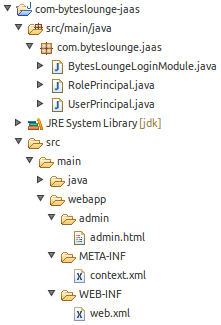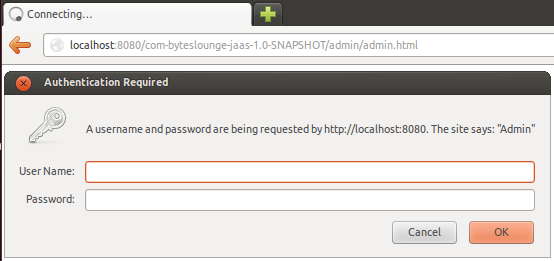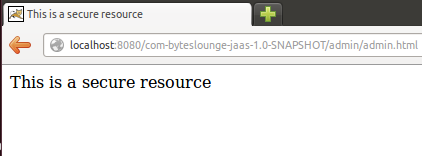JAAS authentication in Tomcat example--reference
Introduction
Tomcat provides a default JAAS Realm implementation so developers may implement JAAS Login Modules and easily integrate them with the container. In this tutorial we will implement all the required components to put JAAS up and running in Tomcat web container.
This tutorial considers the following software and environment:
- Ubuntu 12.04
- JDK 1.7.0.09
- Tomcat 7.0.35
The Principals
One of the core concepts of JAAS is the existence of users and roles (roles are similar to groups in UNIX systems). Authorization may be issued to specific users or to roles. In JAAS this is concept is translated to Principals: Principals may represent users orroles independently. Let's define User and Role Principals to be used in this example:
package com.byteslounge.jaas;
import java.security.Principal;
public class UserPrincipal implements Principal {
private String name;
public UserPrincipal(String name) {
super();
this.name = name;
}
public void setName(String name) {
this.name = name;
}
@Override
public String getName() {
return name;
}
}
package com.byteslounge.jaas;
import java.security.Principal;
public class RolePrincipal implements Principal {
private String name;
public RolePrincipal(String name) {
super();
this.name = name;
}
public void setName(String name) {
this.name = name;
}
@Override
public String getName() {
return name;
}
}
Basically we are defining two simple Principals, each one of them requiring just a name so they may be promptly identified (a username or a role name). Remember that our principals must implement the java.security.Principal interface.
The Login Module
Now we need to define a Login Module that will actually implement the authentication process. The Login module must implement the javax.security.auth.spi.LoginModule interface:
package com.byteslounge.jaas; import java.io.IOException;
import java.util.ArrayList;
import java.util.List;
import java.util.Map; import javax.security.auth.Subject;
import javax.security.auth.callback.Callback;
import javax.security.auth.callback.CallbackHandler;
import javax.security.auth.callback.NameCallback;
import javax.security.auth.callback.PasswordCallback;
import javax.security.auth.callback.UnsupportedCallbackException;
import javax.security.auth.login.LoginException;
import javax.security.auth.spi.LoginModule; public class BytesLoungeLoginModule implements LoginModule { private CallbackHandler handler;
private Subject subject;
private UserPrincipal userPrincipal;
private RolePrincipal rolePrincipal;
private String login;
private List<String> userGroups; @Override
public void initialize(Subject subject,
CallbackHandler callbackHandler,
Map<String, ?> sharedState,
Map<String, ?> options) { handler = callbackHandler;
this.subject = subject;
} @Override
public boolean login() throws LoginException { Callback[] callbacks = new Callback[2];
callbacks[0] = new NameCallback("login");
callbacks[1] = new PasswordCallback("password", true); try {
handler.handle(callbacks);
String name = ((NameCallback) callbacks[0]).getName();
String password = String.valueOf(((PasswordCallback) callbacks[1])
.getPassword()); // Here we validate the credentials against some
// authentication/authorization provider.
// It can be a Database, an external LDAP,
// a Web Service, etc.
// For this tutorial we are just checking if
// user is "user123" and password is "pass123"
if (name != null &&
name.equals("user123") &&
password != null &&
password.equals("pass123")) { // We store the username and roles
// fetched from the credentials provider
// to be used later in commit() method.
// For this tutorial we hard coded the
// "admin" role
login = name;
userGroups = new ArrayList<String>();
userGroups.add("admin");
return true;
} // If credentials are NOT OK we throw a LoginException
throw new LoginException("Authentication failed"); } catch (IOException e) {
throw new LoginException(e.getMessage());
} catch (UnsupportedCallbackException e) {
throw new LoginException(e.getMessage());
} } @Override
public boolean commit() throws LoginException { userPrincipal = new UserPrincipal(login);
subject.getPrincipals().add(userPrincipal); if (userGroups != null && userGroups.size()>0){for(String groupName : userGroups){
rolePrincipal =newRolePrincipal(groupName);
subject.getPrincipals().add(rolePrincipal);}}returntrue;}@Overridepublicboolean abort()throwsLoginException{returnfalse;}@Overridepublicboolean logout()throwsLoginException{
subject.getPrincipals().remove(userPrincipal);
subject.getPrincipals().remove(rolePrincipal);returntrue;}}
All the implemented methods are inherited from javax.security.auth.spi.LoginModule interface and will be called by Tomcat at specific moments during the authentication process.
The login method is responsible for checking if the credentials provided by the end user are valid. This check is made against any kind of authorization entity: It may be a database, a web service, a LDAP, etc. The developer may implement this credentials check in the way required by some specific use case.
Note: The login method must throw a LoginException in case of authentication failure.
In the presence of a successful authentication it should fetch the roles associated with the authenticating user. In this case we simulated and hard coded the admin role as a fetched role from the credentials provider for the current user.
The commit method is called after a successful login method execution and is responsible to store the user and roles obtained by the login method in the respective Subject and in the form of Principals. As you can see in the above module implementation, during the login method execution the credentials are obtained by the means of a callback. This callback is initialized in the initialize method together with Subject initialization.
The logout method is called when the user logs out of the system (and the application implements a logout mechanism). Finally the abort method is called when the login method fails to authenticate the user (throws a LoginException).
The web application
In this example we will secure a specific folder of a Java web application. The application will be very simple and its structure is the following:

We will be securing the admin folder.
To accomplish this task we must define some configuration elements in web.xml file. These entries go directly under the web-app element:
<security-constraint>
<web-resource-collection>
<web-resource-name>Admin</web-resource-name>
<url-pattern>/admin/*</url-pattern>
</web-resource-collection>
<auth-constraint>
<role-name>admin</role-name>
</auth-constraint>
</security-constraint> <security-role>
<role-name>admin</role-name>
</security-role> <login-config>
<auth-method>BASIC</auth-method>
<realm-name>Admin</realm-name>
</login-config>
In security-constraint element we are defining that all resources under /admin folder are protected and only the admin role is granted to access the resources. All existing roles must be also defined in the security-role element. The login-configelement defines how the credentials will be asked to the end user. In this example we will use the Basic authentication scheme (you may have different mechanisms like presenting a web form or page to the end user, but that will be covered in other tutorial).
Now we must define a new file named context.xml and place it under:
/META-INF/context.xml
<?xml version="1.0" encoding="UTF-8"?>
<Context>
<Realm className="org.apache.catalina.realm.JAASRealm"
appName="BytesLoungeLogin"
userClassNames="com.byteslounge.jaas.UserPrincipal"
roleClassNames="com.byteslounge.jaas.RolePrincipal" />
</Context>
Here we define the class that will implement the JAAS realm. We are using Tomcat default implementation:org.apache.catalina.realm.JAASRealm. We also define which classes will implement the user and roles Principals and we set them to be the ones we defined earlier in this tutorial (UserPrincipal and RolePrincipal). The attribute appName defines how the application will be globally identified by Tomcat in what matters to security configuration.
Finally we must define a JAAS configuration file. We will name it jaas.config and we will place it in Tomcat conf folder:
$CATALINA_BASE/conf/jaas.config
The file looks like the following:
BytesLoungeLogin {
com.byteslounge.jaas.BytesLoungeLoginModule required debug=true;
};
This file defines the authentication configuration for BytesLoungeLogin application. Note that it's the same name we used inappName inside context.xml file just above.
Launching Tomcat and testing
Now lets launch Tomcat. We must set a JVM argument that tells Tomcat where the application configuration security file is located, the jaas.config file:
You may set this in the startup catalina.sh file.
When the server is up and running and we access the secure resource:
We will see the Basic authentication dialog asking for credentials:

Now we insert the credentials we hard coded in our Login Module. Username: user123 and Password: pass123
We will be presented the secure resource. Access was granted.

The tutorial full source code is available for download at the end of this page.
Logout process
For more information about the user logout process please refer to the following article:
Keep in mind that this tutorial covered BASIC authentication so your browser will store the user credentials until it's closed.
This means that even if you logout the user, as soon a new request is made against a protected resource the browser will send the credentials again and automatically authenticate the user.
reference from:
JAAS authentication in Tomcat example--reference的更多相关文章
- Using JAAS Authentication in Java Clients---weblogic document
The following topics are covered in this section: JAAS and WebLogic Server JAAS Authentication Devel ...
- ActiveMQ(5.10.0) - Configuring the JAAS Authentication Plug-in
JAAS provides pluggable authentication, which means ActiveMQ will use the same authentication API re ...
- JAAS - Document
JAAS 参考文档: JAAS Reference Guide JAAS Authentication Tutorial JAAS Authorization Tutorial LoginModule ...
- http://wiki.apache.org/tomcat/HowTo
http://wiki.apache.org/tomcat/HowTo Contents Meta How do I add a question to this page? How do I con ...
- Tomcat创建HTTPS访问,java访问https
一 https和ssL HTTPS(全称:Hyper Text Transfer Protocol over Secure Socket Layer),是以安全为目标的HTTP通道,简单讲是HTTP的 ...
- Tomcat应用中post方式传参数长度限制
Tomcat应用中post方式传参数长度限制 jsp页面上是没有限制的,但是在tomcat服务器上有限制,Tomcat 默认的post参数的最大大小为2M, 当超过时将会出错,可以配置maxPostS ...
- Tomcat web.xml配置参数详解
Apache Tomcat Configuration Reference - The Context Containerhttps://tomcat.apache.org/tomcat-5.5-do ...
- 使用JAAS登录kerberos服务器
java代码: package com.snsprj.jaas0822; import javax.security.auth.*; import javax.security.auth.callba ...
- Tomcat:基础安装和使用教程
背景 此文记录了 Tomcat 的基本使用方法,主要为了强化记忆. 安装步骤 第一步:下载和安装 Java 下载地址:http://www.oracle.com/technetwork/java/ja ...
随机推荐
- 【python】python支持中文变量,醉了
哈哈 = 1 呜呜 = -1 哈哈 + 呜呜 = 0
- 用Org-Mode和Jekll写博客
该文章同时发布在我的github blog上:http://cheukyin.github.io/jekyll/emacs/2014-08/org2jekyll.html 1 前言 在这个月之前,我一 ...
- 超实用,你get了吗?再也不怕本地文件更新到环境用Linux命令重启服务器了。。。
来公司这么久,写过不少代码,可是一碰见关于Linux命令操作的马上绕过,每次都是嚷嚷同事过来帮我替换文件,重启服务器,一直害怕接触命令的我一次一次不嫌麻烦,哈哈.有没有醉了?其实我一直都知道操作不难, ...
- bzoj 1041: [HAOI2008]圆上的整点 本原勾股數組
1041: [HAOI2008]圆上的整点 Time Limit: 10 Sec Memory Limit: 162 MBSubmit: 2027 Solved: 853[Submit][Stat ...
- Nosql database
http://kb.cnblogs.com/page/42731/ http://nosql-database.org/ http://blog.jobbole.com/1344/ http://ww ...
- Student's Morning
sgu242:http://acm.sgu.ru/problem.php?contest=0&problem=242 题意:把n个人分到m组,每一组至少2个人,每个人只能属于一个组.一开始把题 ...
- Match & Catch
Codeforces Round #244 (Div. 2) D:http://codeforces.com/contest/427/problem/D 题意:给你两个串,让你找一个最小的串,并且这个 ...
- iOS,OC,图片相似度比较,图片指纹
上周,正在忙,突然有个同学找我帮忙,说有个需求:图片相似度比较. 网上搜了一下,感觉不是很难,就写了下,这里分享给需要的小伙伴. 首先,本次采用的是OpenCV,图片哈希值: 先说一下基本思路: 1. ...
- android 判断程序是首次(第一次)进入
很多时候,我们需要判断用户是不是第一次进入程序,以决定是不是给用户一些操作提示. 这种功能的实现,说到底还是将数据(一个标志位)存储起来,下次进入程序的时候读取数据进行判断. 我这里只给出一种较简单的 ...
- Eclipse C/C++环境配置
一.C/C++环境配置: Window - Preferences - C/C++ 1. Editor - Content Assist - Auto-Activation - Delay(ms),原 ...
